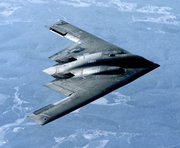Flying wing
|
|
A flying wing is a type of aircraft design with no tail, one in which the majority of the fuselage is inside a thickened wing. Since a wing is necessary for any aircraft, removing everything else theoretically results in a design with the lowest possible drag. A modification in which the fuselage is still retained is known as the tail-less design. Waldo Waterman's Whatsit, considered by some to be the first flying wing, falls in this category.

In traditional aircraft designs, the wing is located such that the weight of the plane is just forward of the center of pressure, the point where all of the lift on the plane balances out. This gives the plane a nose-down tendency. To counteract this, small control surfaces are placed at the end of a long tail which pull down, thereby lifting the nose back up. The basic idea is that the plane can "fly itself" to some degree; by reducing power, and thus lift, the nose naturally lowers itself and the plane starts to descend.
This system, while simple and safe, has several drawbacks. Locating the control surfaces at the end of the tail means that the plane is longer than it "needs" to be, and much of this extended fuselage cannot carry a load due to balance considerations. Moreover the control surfaces' mere existence causes drag on the plane, lowering its performance. But the biggest problem is that these surfaces are pushing down on the plane, in effect making it weigh more. This trim drag requires extra engine power in order to provide extra lift over and above the "dry weight" of the plane.
The same general arrangement, load in front and controls in back of the center of pressure, can be had in another fashion, by bending the wing to the rear. In this case some of the wing is in front and some in back of the center of pressure, and the stability works the same as with external controls. Yet, there are no external controls, and therefore decreased drag and weight. In many situations this can dramatically reduce the overall drag of the plane.
The only disadvantage to this design is that in order to be a useful fuselage, the wing must be thicker than normal. At low speeds this is not a concern, but as the speed of the aircraft approaches the speed of sound a new drag effect appears, one that is based on the relative thickness of the wing. For this reason the flying wing is not appropriate for high-speed aircraft, where the drag is likely to be higher than conventional designs. In addition a number of new stability problems also appear at high speed, notably mach tuck, which the design has a much harder time dealing with.
For this reason the design was studied almost entirely in the 1930s and 1940s, where it was seen as a natural solution to the problem of building an airliner large enough to carry a reasonable passenger load and enough fuel to cross the Atlantic in regular service. The flying wing's large internal volume and low drag made it "a natural" for this role, and was studied in depth by Jack Northrop in the United States, and Alexander Lippisch and the Horten brothers in Germany, where Hugo Junkers had in 1910 patented a wing-only glider concept.
Junkers started work in 1919 on his "Giant" JG1 design, intended to seat passengers within thick wings, but in 1921 the Allied Aeronautical Commission of Control ordered the incomplete JG1 destroyed for exceeding post-war size limits on German aeroplanes. Junkers conceived futuristic flying wings for up to 1,000 passengers; the nearest this came to realisation was in the 1931 Junkers G-38 34-seater Grossflugzeug airliner, which seated passengers in cabins inside the leading edge of the inboard wing panels. One G-38 entered service with Lufthansa; it was later put to military use until being destroyed in 1941. Several late-war German military designs were based on the flying wing, or modifications of it, in order to extend the range of the otherwise very short-range jet engined aircraft. Most famous of these would be the Gotha Go 229 fighter.
After the war a number of experimental designs were based on the planform but the problems soon became evident. Some general interest remained until the early 1950s in order to extend the range of bombers, culminating in the Northrop B-49, which did not enter production. Even the flying wing design could not make up for the fuel use, and much larger conventional aircraft like the Boeing B-52 were built instead.
Interest was renewed in the 1980s as a way of designing an aircraft with the fewest possible parts to show up on radar, which eventually led to the Northrop B-2 Spirit stealth bomber. In this case the aerodynamic advantages of the flying wing are not the important issues.
The design still remains at its best in the slow-to-medium speed range, and there has been continual interest in using it as a tactical airlifter design. Boeing continues to work on paper projects for a Blended Wing Body Lockheed C-130 Hercules sized transport with better range and about 1/3rd more load, while maintaining the same size characteristics. A number of companies, including Boeing, McDonnell Douglas and de Havilland did considerable design work on flying-wing airliners, but to date none have entered production.
See also
- Boeing X-48 (a blended-wing-body design aircraft currently in the design phase)
- Boeing Sonic Cruiser (a blended-wing-body design aircraft designed but never produced, and superseded by the Boeing 787)
External link
- FLIGHT TO THE FUTURE by Joe Mizrahi, Wings, April 1999, Vol. 29, No. 2 (http://members.cox.net/rebid/bldwing.htm)de:Nurflügel

